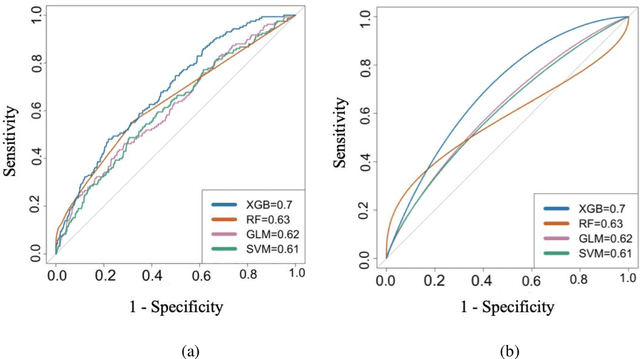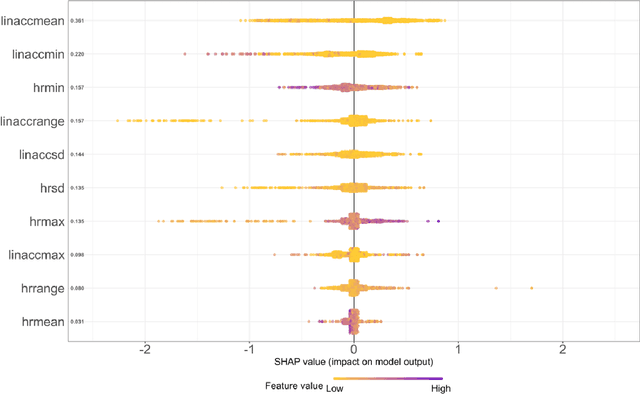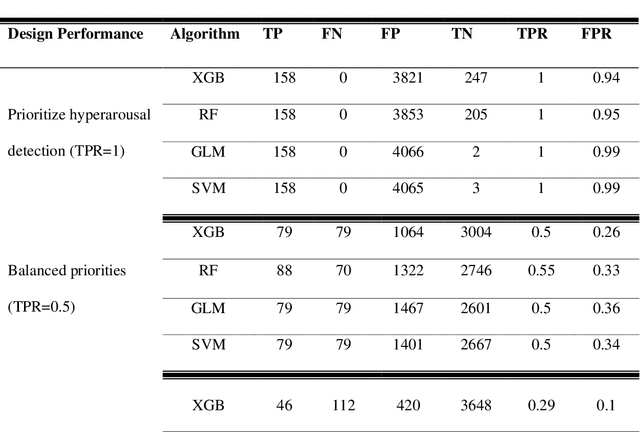Farzan Sasangohar
Real-Time Stress Monitoring, Detection, and Management in College Students: A Wearable Technology and Machine-Learning Approach
May 21, 2025Abstract:College students are increasingly affected by stress, anxiety, and depression, yet face barriers to traditional mental health care. This study evaluated the efficacy of a mobile health (mHealth) intervention, Mental Health Evaluation and Lookout Program (mHELP), which integrates a smartwatch sensor and machine learning (ML) algorithms for real-time stress detection and self-management. In a 12-week randomized controlled trial (n = 117), participants were assigned to a treatment group using mHELP's full suite of interventions or a control group using the app solely for real-time stress logging and weekly psychological assessments. The primary outcome, "Moments of Stress" (MS), was assessed via physiological and self-reported indicators and analyzed using Generalized Linear Mixed Models (GLMM) approaches. Similarly, secondary outcomes of psychological assessments, including the Generalized Anxiety Disorder-7 (GAD-7) for anxiety, the Patient Health Questionnaire (PHQ-8) for depression, and the Perceived Stress Scale (PSS), were also analyzed via GLMM. The finding of the objective measure, MS, indicates a substantial decrease in MS among the treatment group compared to the control group, while no notable between-group differences were observed in subjective scores of anxiety (GAD-7), depression (PHQ-8), or stress (PSS). However, the treatment group exhibited a clinically meaningful decline in GAD-7 and PSS scores. These findings underscore the potential of wearable-enabled mHealth tools to reduce acute stress in college populations and highlight the need for extended interventions and tailored features to address chronic symptoms like depression.
Evaluating Mental Stress Among College Students Using Heart Rate and Hand Acceleration Data Collected from Wearable Sensors
Sep 20, 2023Abstract:Stress is various mental health disorders including depression and anxiety among college students. Early stress diagnosis and intervention may lower the risk of developing mental illnesses. We examined a machine learning-based method for identification of stress using data collected in a naturalistic study utilizing self-reported stress as ground truth as well as physiological data such as heart rate and hand acceleration. The study involved 54 college students from a large campus who used wearable wrist-worn sensors and a mobile health (mHealth) application continuously for 40 days. The app gathered physiological data including heart rate and hand acceleration at one hertz frequency. The application also enabled users to self-report stress by tapping on the watch face, resulting in a time-stamped record of the self-reported stress. We created, evaluated, and analyzed machine learning algorithms for identifying stress episodes among college students using heart rate and accelerometer data. The XGBoost method was the most reliable model with an AUC of 0.64 and an accuracy of 84.5%. The standard deviation of hand acceleration, standard deviation of heart rate, and the minimum heart rate were the most important features for stress detection. This evidence may support the efficacy of identifying patterns in physiological reaction to stress using smartwatch sensors and may inform the design of future tools for real-time detection of stress.
Machine Learning, Deep Learning and Data Preprocessing Techniques for Detection, Prediction, and Monitoring of Stress and Stress-related Mental Disorders: A Scoping Review
Aug 08, 2023Abstract:This comprehensive review systematically evaluates Machine Learning (ML) methodologies employed in the detection, prediction, and analysis of mental stress and its consequent mental disorders (MDs). Utilizing a rigorous scoping review process, the investigation delves into the latest ML algorithms, preprocessing techniques, and data types employed in the context of stress and stress-related MDs. The findings highlight that Support Vector Machine (SVM), Neural Network (NN), and Random Forest (RF) models consistently exhibit superior accuracy and robustness among all machine learning algorithms examined. Furthermore, the review underscores that physiological parameters, such as heart rate measurements and skin response, are prevalently used as stress predictors in ML algorithms. This is attributed to their rich explanatory information concerning stress and stress-related MDs, as well as the relative ease of data acquisition. Additionally, the application of dimensionality reduction techniques, including mappings, feature selection, filtering, and noise reduction, is frequently observed as a crucial step preceding the training of ML algorithms. The synthesis of this review identifies significant research gaps and outlines future directions for the field. These encompass areas such as model interpretability, model personalization, the incorporation of naturalistic settings, and real-time processing capabilities for detection and prediction of stress and stress-related MDs.
Posttraumatic Stress Disorder Hyperarousal Event Detection Using Smartwatch Physiological and Activity Data
Oct 01, 2021



Abstract:Posttraumatic Stress Disorder (PTSD) is a psychiatric condition affecting nearly a quarter of the United States war veterans who return from war zones. Treatment for PTSD typically consists of a combination of in-session therapy and medication. However; patients often experience their most severe PTSD symptoms outside of therapy sessions. Mobile health applications may address this gap, but their effectiveness is limited by the current gap in continuous monitoring and detection capabilities enabling timely intervention. The goal of this article is to develop a novel method to detect hyperarousal events using physiological and activity-based machine learning algorithms. Physiological data including heart rate and body acceleration as well as self-reported hyperarousal events were collected using a tool developed for commercial off-the-shelf wearable devices from 99 United States veterans diagnosed with PTSD over several days. The data were used to develop four machine learning algorithms: Random Forest, Support Vector Machine, Logistic Regression and XGBoost. The XGBoost model had the best performance in detecting onset of PTSD symptoms with over 83% accuracy and an AUC of 0.70. Post-hoc SHapley Additive exPlanations (SHAP) additive explanation analysis showed that algorithm predictions were correlated with average heart rate, minimum heart rate and average body acceleration. Findings show promise in detecting onset of PTSD symptoms which could be the basis for developing remote and continuous monitoring systems for PTSD. Such systems may address a vital gap in just-in-time interventions for PTSD self-management outside of scheduled clinical appointments.
 Add to Chrome
Add to Chrome Add to Firefox
Add to Firefox Add to Edge
Add to Edge